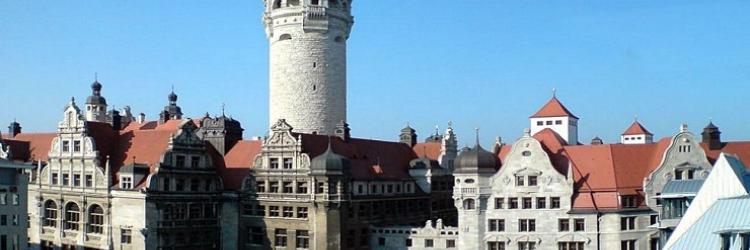Other Comments: 0 May 30, 2017
The city of Leipzig is located in the Free State of Saxony and is one of the medium sized cities in Germany with its approximately 510,000 inhabitants. Situated in the North German lowlands, the city was a center of book printing and book trading. The composer Johann Sebastian Bach worked here, developing a century-long Leipzig music history. Culinary, the city has the Leipziger Allerlei, a vegetable dish a world famous specialty to offer.
St. Nicholas Church is one of the most important landmarks and the largest church in the city. It was already built in 1165, while its first bell was built in 1452. As the most famous church in the city, it has also been a place of many historical moments during the past centuries. On Good Friday in 1724 Johann Sebastian Bach performed here his Johannespassion for the first time. The famous Mondays demonstrations against the GDR regime had their origin in the Monday prayers of the St. Nikolas Church. It was not without reason that the church was also the starting point of the peaceful revolution in 1989, which finally led to the fall of the Wall. In 2015 the temple celebrated its 850th anniversary. Visits and guided tours of the church are free.
In memory of the Battle of the Nations near Leipzig in the year 1813 the monument was inaugurated about 100 years later in the southeast of Leipzig. Bruno Schmitz designed the monument, which was then moulded by Christian Behrens and Franz Metzner. In front of the 91-meter-high monument lies the Lake of Tears around the fallen soldiers. Not far from the monument are bus and metro stations. The National Monument is one of the largest in Europe and is one of the most famous landmarks of the city of Leipzig.
Another important sacral building is the St. Thomas Church. It gained worldwide fame as the center of performance of the Leipzig composer Johann Sebastian Bach and the Thomaner choir (St. Thomas Choir of Leipzig). The Thomaskirche is especially worth seeing because of its opulent interior, including one of Germany's steepest gabled roofs. Here is also the tomb of Johann Sebastian Bach, who died in July 1750 and was also immortalized in the magnificent church windows. Another Bach monument is in can be found in front of the church. No wonder, many works by the composer were premiered in the St. Thomas Church.
The Main Station: Since its opening in 1915, it has shaped the cityscape of Leipzig as hardly any other building. With a size of 83,000 square meters, the Main Station is Europe's largest head station. It is also the center of Leipzig's transport network and a popular shopping and excursion destination for tourists. Restaurants and over 140 shops fill the three floors inside the train station. There are regular exhibitions in the corridors of the station. 120,000 visitors rush through the railway station every day. Since the integration of the S-Bahn city tunnel in 2013, there are even more people passing through the station.
The Market and the Old Town Hall: The Leipzig Market is regarded as the heart of the city. From here you can reach all the sights and have the Old Town Hall in front of you. The approximately one hectare Market square was already used in the 16th century as a goods handling area, court and market place. Today there are weekly markets, the Easter market and every year in December the famous, traditional Leipzig Christmas market. It is also home to one of the oldest buildings in Leipzig, the Old Town Hall. As early as 1556 the foundation stone was laid for the museum today. The Banquet Hall formerly served as a venue for balls and aristocratic weddings. Today, cultural and concert events also take place here.
Zoological Garden Leipzig: In addition to the Berlin Zoo and the Hanoverian counterpart, the Zoological Garden is among the oldest and best known zoos in Germany. The site is currently being transformed into a zoo of the future. From 2020 onwards, modernization will follow in the individual areas. The founder of the project was Ernst Pinkert, who invested into a private zoo on two hectares. Today, the zoo in Leipzig comprises around 23.2 hectares. Currently, there are over 800 species and 1,600 animals. Particularly popular are the Gondwanaland Hall, a 16,500 m² jungle landscape and the Kiwara savannah with giraffes, elephants and Co. The elephant temple Ganesha Mandir is also in demand. The zoo is open for visitors all year round, and entry fee costs 13.00 euros.
Bach Museum: The famous son of the city is omnipresent in the music city of Leipzig. Museums and monuments recall the work of Johann Sebastian Bach. Probably the most famous is the Bach Museum, which was opened to visitors since 1985. To date, 850,000 have come to know more about the composer's work and life. It is part of the Bach Archive in the historic Bosehaus. The Bach Museum can be visited Tuesday to Sunday for about 8.00 euros.
Parks: Leipzig is famous for its many green areas, roads and parks. One of the most beautiful is the Clara-Zetkin Park, which was created in 1955 by merging of five other parks. Hardly any other park is more historical and more extensive than the Park near the New Town Hall. Here you will find an old racetrack, the Pleiße river bed and a main avenue with a four-rowed linden trees. There are also cafes, an open-air stage and other cultural activities within the park. Further green areas you should see during your city tour are the Johanna Park, the Palm Garden and the Richard-Wagner Grove.
Leipzig is much more than just the new Berlin! In recent years, Leipzig has been transformed from an easily surveyable location to the modern scene and student city "Hypezig". Concerts, art exhibitions, flea markets and historical city districts await those who choose to go on a city tour. Sights such as the Monument of the Battleof the Nations bear witness to the long history of Leipzig. Every year, there are also the book fair and numerous events at the university.


 RS
RS  ME
ME  HR
HR  BA
BA  RU
RU  MK
MK  AL
AL  ES
ES  DE
DE  IT
IT  CN
CN  NL
NL  SE
SE  FR
FR 






Write a comment